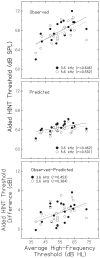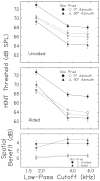Spatial benefit of bilateral hearing AIDS
- PMID: 19194292
- PMCID: PMC3693091
- DOI: 10.1097/AUD.0b013e31819769c1
Spatial benefit of bilateral hearing AIDS
Abstract
Objectives: To assess the extent to which hearing aids improve spatial benefit by restoring the availability of interaural difference cues, the benefit attributable to spatial separation of speech and babble with and without bilateral hearing aids was measured as a function of low-pass cutoff frequency.
Design: Twenty-one older adults with sloping high-frequency hearing loss were provided commercially available bilateral hearing aids. After a 3 to 6 month acclimatization period, speech levels corresponding to 50% correct recognition of sentences from the Hearing in Noise Test (HINT) were measured in a 65-dB SPL babble, with speech and babble low-pass filtered at 1.8, 3.6, and 5.6 kHz. Sentences were always at 0 degrees azimuth, and babble was at either 0 degrees or 90 degrees . Speech and babble spectra for all conditions were digitally recorded using a probe microphone placed in each ear canal of each subject. Spectra and levels of speech and babble and unaided thresholds for narrowband noises were used to calculate the aided audibility index and provide predictions of unaided and aided thresholds for HINT sentences, hearing aid benefit, and spatial benefit for each cutoff frequency. In addition, subjects' willingness to tolerate background noise with and without amplification was measured in the spatially coincident and spatially separated conditions using the Acceptable Noise Level (ANL) procedure.
Results: Thresholds for HINT sentences in babble and ANL improved significantly when aided and when speech and babble were spatially separated. Specifically, hearing aid benefit improved significantly as cutoff frequency increased from 1.8 to 3.6 kHz but only when speech and babble were spatially separated; likewise, spatial benefit improved significantly from 1.8 to 3.6 kHz but only in the aided condition. No further improvement in hearing aid or spatial benefit was observed when cutoff frequency was increased from 3.6 to 5.6 kHz, although improvement in hearing aid benefit was predicted.
Conclusions: Hearing aid benefit, although significant, was poorer than predicted, suggesting that these older adults with high-frequency hearing loss did not take full advantage of the increase in audible speech information provided by amplification. Hearing aid benefit was also limited because hearing aids for some subjects did not restore speech audibility across the full bandwidth of speech. Unaided and aided spatial benefit was significantly greater than predicted, and aided spatial benefit was greater than unaided. This suggests that these older adults were able to take advantage of interaural level and time difference cues to improve speech recognition in babble and that they benefited from these cues to a greater extent with than without bilateral hearing aids. Finally, in contrast to results of previous studies, ANL may vary for an individual depending on the listening condition.
Figures









Similar articles
-
Spatial separation benefit for unaided and aided listening.Ear Hear. 2014 Jan-Feb;35(1):72-85. doi: 10.1097/AUD.0b013e3182a02274. Ear Hear. 2014. PMID: 24121648 Free PMC article.
-
Speech recognition performance of patients with sensorineural hearing loss under unaided and aided conditions using linear and compression hearing AIDS.Ear Hear. 2002 Aug;23(4):280-90. doi: 10.1097/00003446-200208000-00003. Ear Hear. 2002. PMID: 12195170
-
Spectral contributions to the benefit from spatial separation of speech and noise.J Speech Lang Hear Res. 2002 Dec;45(6):1297-310. doi: 10.1044/1092-4388(2002/104). J Speech Lang Hear Res. 2002. PMID: 12546495
-
Are individual differences in speech reception related to individual differences in cognitive ability? A survey of twenty experimental studies with normal and hearing-impaired adults.Int J Audiol. 2008 Nov;47 Suppl 2:S53-71. doi: 10.1080/14992020802301142. Int J Audiol. 2008. PMID: 19012113 Review.
-
Acceptable noise level as a deciding factor for prescribing hearing aids for older adults with cochlear hearing loss - A scoping review.J Otol. 2015 Sep;10(3):93-98. doi: 10.1016/j.joto.2015.10.002. Epub 2015 Nov 11. J Otol. 2015. PMID: 29937789 Free PMC article.
Cited by
-
Previous binaural experience supports compensatory strategies in hearing-impaired children's auditory horizontal localization.PLoS One. 2024 Dec 5;19(12):e0312073. doi: 10.1371/journal.pone.0312073. eCollection 2024. PLoS One. 2024. PMID: 39637020 Free PMC article.
-
Aided and unaided speech perception by older hearing impaired listeners.PLoS One. 2015 Mar 2;10(3):e0114922. doi: 10.1371/journal.pone.0114922. eCollection 2015. PLoS One. 2015. PMID: 25730423 Free PMC article.
-
Evaluation of Speech Recognition Skills in Different Noises with the Turkish Matrix Sentence Test in Hearing Aid Users.Turk Arch Otorhinolaryngol. 2021 Jun;59(2):133-138. doi: 10.4274/tao.2021.6179. Epub 2021 Jul 30. Turk Arch Otorhinolaryngol. 2021. PMID: 34386800 Free PMC article.
-
Validating a Rapid, Automated Test of Spatial Release From Masking.Am J Audiol. 2017 Dec 12;26(4):507-518. doi: 10.1044/2017_AJA-17-0013. Am J Audiol. 2017. PMID: 28973106 Free PMC article.
-
A factor analysis of the SSQ (Speech, Spatial, and Qualities of Hearing Scale).Int J Audiol. 2014 Feb;53(2):101-14. doi: 10.3109/14992027.2013.824115. Epub 2013 Sep 9. Int J Audiol. 2014. PMID: 24417459 Free PMC article.
References
-
- Abel SM, Giguère C, Consoli A, et al. The effect of aging on horizontal plane localization. J Acoust Soc Am. 2000;108:743–752. - PubMed
-
- American National Standards Institute. Methods for the Calculation of the Articulation Index. New York, NY: American National Standards Institute; 1969. (ANSI S3.5–1969)
-
- American National Standards Institute. American National Standard: Testing Hearing Aids with a Broadband Noise Signal. New York, NY: American National Standards Institute; 1992. (ANSI S3.42–1992)
-
- American National Standards Institute. American National Standard Specifications for Calculation of the Speech Intelligibility Index. New York, NY: American National Standards Institute; 1997. (ANSI S3.5–1997)
-
- American National Standards Institute. American National Standard Specifications for Audiometers. New York, NY: American National Standards Institute; 2004. (ANSI S3.6–2004)
Publication types
MeSH terms
Grants and funding
LinkOut - more resources
Full Text Sources
Medical
Miscellaneous

